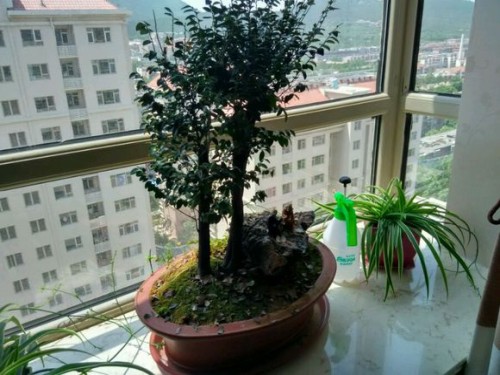How to trim the bonsai of winter red fruit
Winter red fruit is a variety of apple, its tree shape is compact, the spring light pink flowers are full of branches, the autumn and winter trees are covered with exquisite and lovely fruit, its fruit shape is very similar to apple, suitable for garden planting or potted ornamental, bonsai production.
Sometimes in order to watch the needs, some of the winter red fruit is not cut, and the flower and fruit co-exist in the flowering period of the following April. Some people in order to appreciate the small crystal clear, colorful, dense, full of branches of winter red fruit, the leaves are removed. After the initial cultivation of bonsai, pruning is the key link to stabilize the shape of the tree, control the height of the crown and reach full flowers and fruits.

1. Pruning during the growing period
In spring, the sprouts of non-directional culture were wiped out in time, and the buds of directional culture were supplied with concentrated nutrition. Pruning measures such as ring cutting (carving), branch pulling and twisting were mainly adopted to promote the transformation of tree nutrition accumulation to flower buds. When the new shoots grow above 20cm in summer, coring can be carried out many times to control exuberant growth, achieve a stable tree shape, and promote the formation of flower buds in the middle and lower parts of new branches.
Pruning and shaping the plant before germination in spring to cut off the diseased branches, cross branches, overdense branches and overgrown branches, and to truncate the overlong branches to facilitate ventilation and light transmission, and to keep the tree shape graceful.
2. Dormant pruning
Winter red fruit enters the dormant period after falling leaves, which is the best time for shaping and pruning. Under the premise of a stable tree shape, the branches with axillary flower buds on all levels of lateral branches are truncated, and the length left by the truncation is generally in 5~l0cm, pay attention to the short cut of flower buds, retain the medium and short fruit branches, very short branches and leaf clumps, and remove the dense branches, thin and weak branches, diseased branches, cross branches and long branches; and light cut the branches with strong growth potential, up to the weak buds, or slowly put, you can also pull the branches to open angle.
Branches that are not sure of flower buds can be re-pruned before flowering, remember not to overprune, otherwise it will cause fruit trees to flourish and it will be difficult to blossom and bear fruit. Leave pile 6~10cm during winter shearing, increase plant spacing or replant in the coming year, cultivate lateral branches according to modeling design, and complete basic modeling. The tree after winter pruning requires uniform distribution of branches and flower buds, reasonable space, combination of deficiency and reality, and balance of tree potential.
Time: 2019-06-10 Click:
- Prev

How to shape the bonsai of Luohansong
The bonsai trees of Luohan pine are lush and elegant, ancient and vigorous, with bright green leaves all the year round, with a sense of vitality and nobility. If attached to the rock, made into the posture of eagle claw holding stone, more quaint and chic. Luo Hansong and bamboo, stone group scenery, extremely elegant. Jungle style Luohan pine bonsai, coupled with grazing scenery, can give people a wild enjoyment.
- Next

Modeling Design method of Winter Red Fruit Bonsai
Winter red fruit is generally straight and natural shape, the trunk is erect or slightly curved, branched at a certain height, suitable for varieties with upright tree posture and small branches and leaves, such as winter red fruit and rose autumn. In the oblique dry type, the tree is planted at one end of the pot, the trunk is tilted to the other end, and the inclined trunk is not less than half the total length of the trunk.
Related
- Fuxing push coffee new agricultural production and marketing class: lack of small-scale processing plants
- Jujube rice field leisure farm deep ploughing Yilan for five years to create a space for organic food and play
- Nongyu Farm-A trial of organic papaya for brave women with advanced technology
- Four points for attention in the prevention and control of diseases and insect pests of edible fungi
- How to add nutrient solution to Edible Fungi
- Is there any good way to control edible fungus mites?
- Open Inoculation Technology of Edible Fungi
- Is there any clever way to use fertilizer for edible fungus in winter?
- What agents are used to kill the pathogens of edible fungi in the mushroom shed?
- Rapid drying of Edible Fungi

